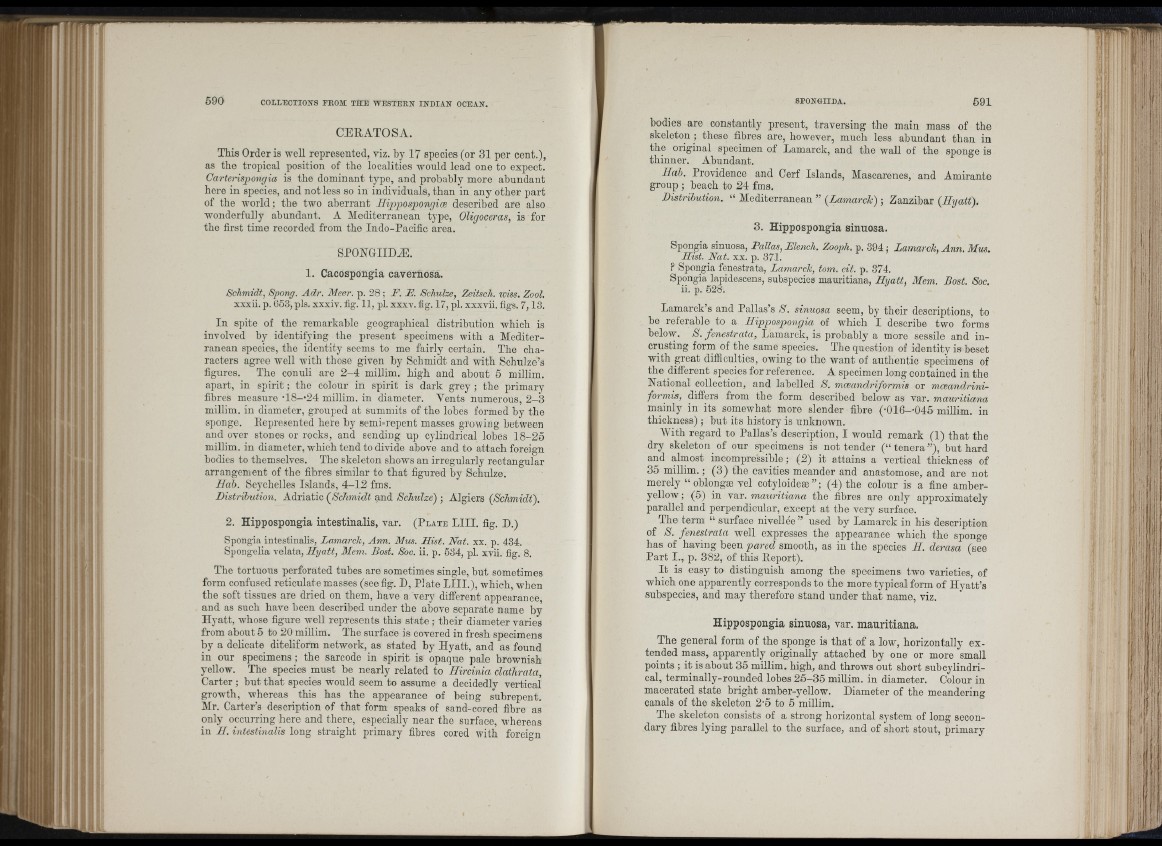
I ' m3
1
i I
- r f . j i
CERATOSA.
This Order is well represented, viz. by 17 species (or 31 per cent.),
as tbe tropical position of tho localities would lead one to expect.
Carterispongia is tbe dominant fepe, and probably more abundant
bore in species, and not less so in individuals, than in any otber part
of the world; tbe two aberrant Hippospongicje described are also
wonderfully abundant. A Mediterranean type, Oligoceras, is for
tbe first time recorded from tbe Indo-Pacific area.
SPONGIIDiE.
1. Cacospongia cavernosa.
Schmidt, Sqjong. Adr. Meer. p. 28 ; F. E. Schulze, Zeitsch. iviss. Zool.
xxxii. p. 053, pis. xxxiv. fig. 11, pi. xxxv. fig. 17, pi. xxxvii. figs. 7,13.
In spite of tbe remarkable geographical distribution which is
involved by identifying the present specimens witb a Mediterranean
species, the identity seems to me fairly certain. Tbe characters
agree well with those given by Schmidt and witb Schulze’s
figures. The conuli are 2 -4 millim. high and about 5 millim.
apart, in s p ir it; the colour in spirit is dark grey ; tbe primary
fibres measure •18-*24 millim. in diameter. Vents numerous, 2 -3
millim. in diameter, grouped at summits of tbe lobes formed by tbe
sponge. Represented here by semi-repent masses growing between
aud over stones or rocks, and sending up cylindrical lobes 18-25
millim. in diameter, which tend to divide above and to attach foreign
bodies to themselves. Tbe skeleton shows an irregularly rectangular
arrangement of the fibres similar to th at figured by Schulze.
Hah. Seychelles Islands, 4 -12 fms.
Distrihution. Adriatic {Schmidt and Schulze) ; Algiers {Schmidt).
2. Hippospongia intestinalis, var. ( P l a t e L III. fig. D.)
Spongia intestinalis, Lamarck, Ann. Mus. Hist. Nat. xx. p. 434,
Spongelia velata, Hyatt, Alem. Bost. Soc. ii, p. 534, pi. xvii. fig. 8.
The tortuous perforated tubes are sometimes single, but sometimes
form confused reticulate masses (see fig. D, Plate L III.), wbicb, when
the soft tissues are dried on them, have a very diiferent appearance,
and as such bave been described under tbe above separate name by
Hyatt, whose figure well represents this state ; their diameter varies
from about 5 to 20 millim. The surface is covered in fresh specimens
by a delicate diteliform network, as stated by Hyatt, and as found
in our specimens ; tbe sarcode in spirit is opaque pale brownish
yellow. Tbe species must be nearly related to Hircinia clathrata.
C a rte r; but th at species would seem to assume a decidedly vertical
growth, whereas this bas tbe appearance of being subrepent.
Mr. Carter’s description of that form speaks of sand-cored fibre as
only occurring here and there, especially near the surface, whereas
in H. intestinalis long straight primary fibres cored with foreign
bodies are constantly present, traversing the main mass of the
skeleton ; these fibres are, however, much less abundant than in
the original specimen of Lamarck, and the wall of the sponge is
thinner. Abundant.
Hah. Providence and Cerf Islands, Mascarenes, and Amirante
group ; beach to 24 fms.
Distrihution. “ Mediterranean ” {Lamardc) ; Zanzibar {Hyatt).
3. Hippospongia sinnosa.
Spongia siniiosa, Pallas, Elench. Zooph. p. 394; Lamarck, Ann. Mus,
Hist. Nat. XX. p. 371.
P Spongia fenestrata, Lamarck, tom. cit. p. 374.
Spongia lapidescens, subspecies mam’itiana, Hyatt, Mem. Bost. Soc.
ii. p. 528.
Lamarck’s and Pallas’s S . sinuosa seem, by their descriptions, to
be referable to a Hippospongia of which I describe two forms
below. S. fenestrata, Lamarck, is probably a more sessile and incrusting
form of the same species. The question of identity is beset
with p e a t difiiciilties, owing to the want of authentic specimens of
the different species for reference. A specimen long contained in the
National collection, and labelled S. mceandriformis or mceandrini-
formis, differs from the form described below as var. mauritiana
mainly in its somewhat more slender fibre (•016--045 millim. in
thickness) ; but its history is unknown.
AVitb regard to Pallas’s description, I would remark (1) th at tbe
dry skeleton of our specimens is not tender (“ ten e ra ”), but bard
and almost incompressible; (2) it attains a vertical thickness of
35 millim.; (3 ) the cavities meander and anastomose, and are not
merely “ oblongae vel cotyloidete ” ; (4) the colour is a fine amber-
yellow ; (5) in var. mauritiana the fibres are only approximately
parallel and perpendicular, except at the very surface.
Tbe term “ surface nivellee ” used by Lamarck in his description
of S. fenestrata well expresses the appearance wbicb tbe sponge
has of having been pared smooth, as in tbe species H. derasa (see
P a rt I., p. 382, of tbis Report).
I t is easy to distinguish among the specimens two varieties, of
which one apparently corresponds to tbe more typical form of Hyatt’s
subspecies, and may therefore stand under th a t name, viz.
Hippospongia sinnosa, var. mauritiana.
The general form of tbe sponge is th at of a lovq horizontally extended
mass, apparently originally attached by one or more small
points ; it is about 35 millim. high, and throws out short subcylindrical,
terminally-rounded lobes 25-35 millim. in diameter. Colour in
macerated state bright amber-yellow. Diameter of tbe meandering
canals of tbe skeleton 2-5 to 5 millim.
The skeleton consists of a strong horizontal system of long secondary
fibres lying parallel to the surface, and of short stout, primary
I I
l i
0 jil